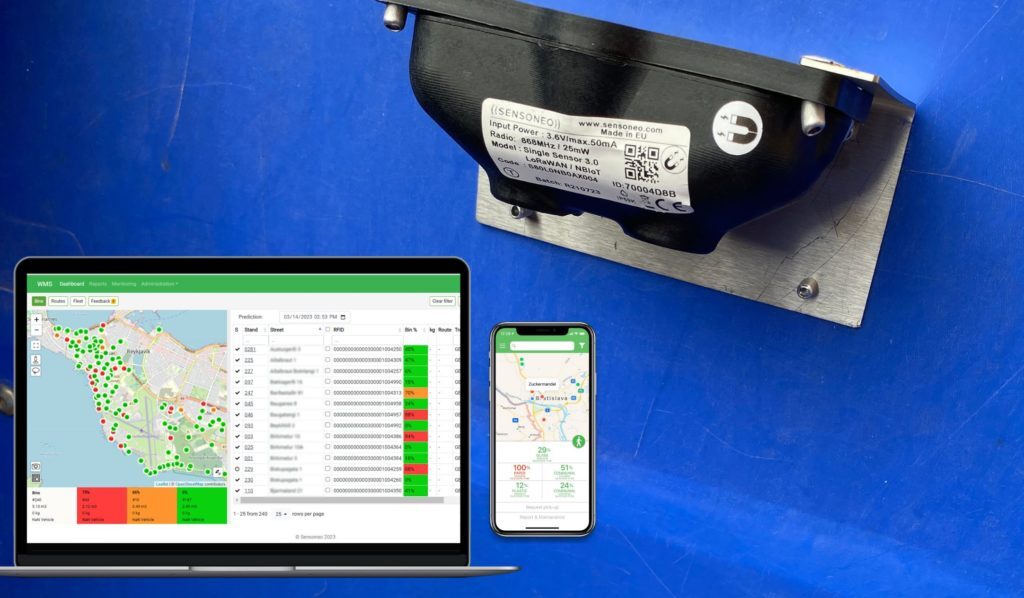When it comes to waste collection, smart sensors have proved a game-changing technology to address pressing challenges. Measuring waste fill levels enables municipalities and waste collection companies to gather precious data on waste production, change collection days, or introduce dynamic waste collection and optimize waste routes. As a result, smart waste monitoring helps cut costs, reduce environmental impact, and provide better services for citizens.
Ultrasonic smart sensors are the standard go-to option for monitoring waste fill levels. They are widely used due to their accuracy, non-contact measurement, and ability to function well in various environmental conditions. Thanks to those attributes they can be used in practically any type of bin with various kinds of waste. Here are the top waste streams that can benefit from deploying smart sensors:

1. Municipal solid waste (MSW)
Municipal solid waste or household waste is one of the most significant waste streams in urban areas. MSW production is complex and dynamic; sensors can provide valuable insights and enable operators to make informed decisions. One of the most significant advantages of sensors is introducing dynamic collection, however thanks to the data and filling cycles predictions, also frequency-based waste collection can be improved. The best efficiency within municipal solid waste can be measured by using smart sensors inside semi-underground and underground bins, as the filling cycles are unpredictable. Furthermore, collection of these bins is time and cost-demanding, because a waste truck with a hydraulic arm is needed for the pick-up.

2. E-waste
Waste from electrical and electronic equipment (WEEE) is one of the fastest-growing waste streams globally. On one hand, it can pose risk to the environment and to public health as it contains hazardous materials, on the other, it is also a very good source of scarce and valuable resources. That is why proper collecting and handling is key.

Dedicated e-waste boxes or bins are a good way to collect WEEE and this waste stream may benefit not only from waste monitoring but also from a more complex take-back solution. Sensoneo provides such a system to nationwide WEEE collector Asekol, maximizing efficiency with accurate real-time data.
3. Glass
Glass recycling is essential for conserving raw materials and reducing landfill waste. In contrast to MSW, glass waste usually has an irregular filling pattern. And while at times the collection vehicles find the glass bins half-empty, other times they are overflowing causing the glass to end up outside the bin or in the wrong bin. Both these issues can be solved with data from sensors, allowing more efficient collection routes, minimizing carbon footprint, and increasing recycling rates.

4. Textile
Like glass, textile bins also have irregular filling cycles. The speed by which the containers become full is unpredictable, which makes collecting the textile difficult, and servicing the infrastructure of bins and containers can be rather challenging. The smooth collection is however linked to efficient warehouse management, and that is why data from sensors can have a direct impact on the whole operation.

That is also the case of textile bin operator Ekocharita, who saw almost immediate effect of sensor monitoring. The costs for the collection were reduced by 20 %, the time required for collecting one tonne of textile by 30 %, and what increased was the well-being and happiness of textile collectors.
5. Water levels
Although it is not a typical waste stream, water can be monitored with smart sensors as well. There are several benefits to water monitoring, either for the purpose of knowing the levels of fresh water or monitoring manholes to prevent leakages. Monitoring underground water levels in manholes with the help of sensors is ongoing for example in cities in Norway, where it is deployed as an affordable solution to gather data on how much water goes through overflow, and to detect manholes that are getting too full.

In past years, fill-level monitoring sensors became an essential part of smart waste management. Smart sensors have the potential to revolutionize waste management across various waste streams. Apart from the above-mentioned examples they are used in bins with biowaste, paper, plastic or industrial waste, or recycling facilities. By optimizing collection schedules, reducing fuel consumption, and minimizing environmental impact, sensors are an essential tool for creating a more sustainable waste management system.



